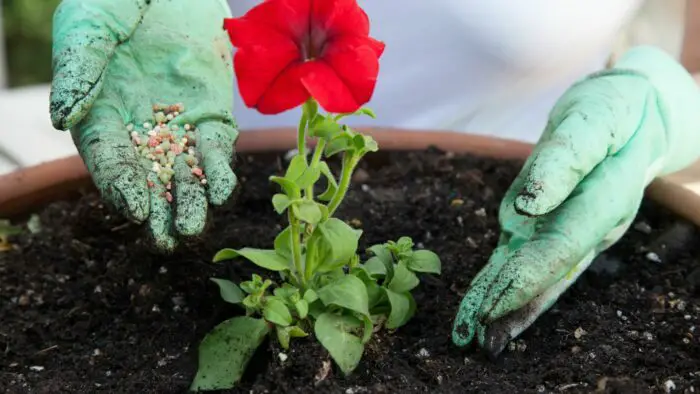Last Updated on March 6, 2023
If you start to notice cal-mag deficiency in flowers, you’ll need to act fast to save your plant’s bloom. During flowering, plants need more magnesium and calcium because of bud production. This is a key productive stage in a plant’s life that requires lots of nutrients to sustain the bloom stage. Calcium and Magnesium are two of the most important secondary nutrients. They are a little less important than the primary nutrients – N, P, K).
The Impact of Cal-Mag on Plants
These two minerals, though secondary, are vital to the biological processes in a plant. Let’s see what each mineral does.
| Calcium Benefits to Plants | Magnesium Benefits to Plants |
|---|---|
| Gives the cell wall more rigidity | Assists in enzyme production |
| Allows plants to have a strong structure and shape | Helps plants make chlorophyll |
| Makes cell walls healthy | Helps plants grow into full maturity |
| Helps the healthy cell wall to regulate the proper transfer of other nutrients | Assists in the absorption and transport of essential nutrients like phosphorous and iron. |
| It is vital for cell division and formation in plants | |
| Activates specific enzymes in plants | |
| Helps transport the organic molecules in plants | |
| Highly essential for the development of healthy fruit structure |
Signs of Cal-Mag Deficiency in Flowers
It is not easy to detect cal mag deficiency in the early stages of a plant. Thus, it is important to act as soon as you detect the first sign. First signs appear in the lower leaves of the plant. The tips of the leaves curl upwards and turn brown. The brown spots increase in size and number starting from the lower to the top part of the plant. The youngest leaves on the top part of the plant also get brown spots with discoloration of veins.
Botanicare HGC732110 Cal-Mag Plus
Read about What is Azomite and How to use it in Gardening
How to Supplement Cal Mag Deficiency in Flowers
Water is one of the essential requirements for all plants. Did you know water is one of the supplements for these secondary nutrients – calcium, and magnesium? Natural water contains abundant calcium and magnesium as dissolved minerals. Plants should be able to get these two nutrients in plenty from the soil/water itself. Tap water also contains these two secondary minerals. You don’t have to worry about using natural water only. Soft water has a low pH with minimal minerals in it.
If you live in an area with low pH, you will have to look for cal-mag supplements for your plants. Hard water contains high concentrations of calcium and magnesium. Using this water means you don’t need to add any Calcium or Magnesium supplements. Treated water requires Cal and Mag supplements addition. Because the distillation process removes the good minerals from the water.
How Much Calcium and Magnesium Should You Use?
You can make a homemade cal-mag supplement using Epsom salts (Magnesium sulfate) and Calcium nitrate. Mix 2 parts calcium to 1 part magnesium. You will need 6g Calcium Nitrate and 4.5g Epsom salts per gallon of water. In specific situations, you might need to adjust the nutrient levels to fit your type of deficiency. If you buy a pre-mixed cal-mag supplement, you will get the right recommended mixture. Stick to those levels for the best results. Remember, excess use of these supplements can be bad for your plants!
When to Stop Cal-Mag in Flowering?
While adding cal-mag to your plants is important, it’s also just as important not to add too much cal-mag. Cal mag usually comes pre-mixed in either a supplement or liquid. When purchasing it like this, it will usually come with instructions on how to apply and how much you should be using. Even if you feel as though your plants are struggling, do not use more than the specified amount and look for potential other issues instead.
The best time to start using cal-mag is when your plants are small. It should be done gradually, in stages, building up the amount as your plant grows. Usually, it’s best to stop as the plant starts to flower, but you don’t have to do this. When it begins to flower after 4-6 weeks, you can simply lower the dosage you’re giving your plants. However, we would recommend sticking to the instructions provided on your supplements.
Can I Use Magnesium Tablets for Plants?
Unfortunately, it’s not recommended to use magnesium tables for plants. When it comes to adding magnesium, it’s best to use a supplement that has been designed specifically for gardening. This will ensure your plants receive the correct amount required to thrive.
Can You Use CalMag Foliar Spray During Flowering?
While CalMag foliar spray is great at many points throughout the cycle of your plant growth, it is not recommended when flowering. Unfortunately, if you use too much when flowering, this can lead to too much moisture in your plants. This can then lead to mold and rot.
Will Cal Mag Tighten Buds?
No. If growing tight flowers, if you use too much cal mag, it can lead to too much moisture and eventually cause mold. If you’re looking to tighten your buds, it’s best to use a bud hardener. Bud hardener is simply a product to add to your flowers when they’re almost finished growing to tighten them. It’s typically used nearer the end of the growth cycle to help them put on weight.
How Do I Know If My Plants Are Lacking Cal-Mag?
You may be wondering how best to tell if your plants are lacking in cal mag. If so, you may want to check for one of the following signs.
- color change. If you become aware that your plants are turning yellow or brown at the tips, this likely means that your plant isn’t receiving enough calcium. However, it’s best to do a soil test to confirm this before you take action.
- slow growth. If you’ve noticed that your plant is growing slower than it should, it may be because it doesn’t have enough calcium or magnesium.
- floppy stems. Your stems may become limp and lifeless if your plant is deficient in magnesium or calcium.
- curly leaves. If you notice that your leaves are curling inwards, it’s likely because they’re not receiving enough calcium.
- rotting. If you notice that your flowers are rotting or becoming smelly, it likely means that your plant is experiencing a lack of calcium.
Conclusion: Cal Mag Deficiency in Flowers
In most cases, these two supplements can be easily available in water and soil. But in exceptional cases, supplements are required. Cal mag supplements are available to buy. But you need to pay attention to the labels. Get something that consists of cal and mag only. Be sure to get a supplement that does not contain other nutrients. Supplements that contain nitrogen and other nutrients bring a risk of over-feeding. This is dangerous to your plants!
Do you have any tips or tricks for helping cal mag deficiency in flowers? If so, please feel free to let us know in the comments below. And remember, sharing is caring!
FAQs
How do you fix Cal-Mag deficiency in flowers?
Calcium is important for the development of new flower buds. Magnesium is also needed to make a healthy flower. If you don't correct it, you will get sickly flowers.
Calcium is one of the most important minerals for plant growth. Calcium helps the plant to grow and bloom. Calcium deficiency will affect the formation of cell walls and cause the flowers to be weak and deformed and cause the plant to grow slowly and may even die. The easiest way to correct Calcium deficiency is to use a Calcium rich fertilizer. You can find Calcium enriched fertilizers at any local nursery or garden center.
Magnesium is an important element for the development of new flower buds. Magnesium deficiency will cause the blooms to have a pale, sickly appearance. Magnesium deficiency will also cause the plant to grow slowly and may even die. The easiest way to correct Magnesium deficiency is to use a Magnesium enriched fertilizer. This will help the plant to get the Magnesium it needs. You can find Magnesium enriched fertilizers at any local nursery or garden center.
How do you add Cal-Mag to plants?
Cal-Mag is a liquid that will raise the pH of your soil. To apply Cal-Mag to your plants, mist them thoroughly with water. Apply 1/4 teaspoon of Cal-Mag per gallon of water. Mist again after 24 hours.
Repeat this process once a week for a month. Cal-Mag is a combination of calcium and magnesium. It can be used on any type of plant except some species of mint. Cal-Mag is particularly useful in preventing stress and disease and in improving the health of plants. The amount of Cal-Mag used should not be more than 1/4 teaspoon per gallon of water. If you use too much, it will cause burns or discoloration.
Can I mix Cal-Mag with nutrients?
You can add nutrients (Vitamin D, Iron, etc.) to a pre-made calcium-magnesium supplement.
Can you use too much Cal-Mag?
Yes, it's possible to over apply. I don't know the exact amount that's bad but it's definitely possible. It won't hurt plants as long as they're not in a nutrient-poor soil or a high pH soil. The more Cal-Mag you use the more of the other nutrients will be left in the soil. If you use Cal-Mag and then fertilizer, it's recommended to add fertilizer at least 24 hours after applying Cal-Mag.
What are the symptoms of calcium deficiency in plants?
Calcium is an essential macronutrient for plant growth and development. It is involved in a number of physiological processes including cell division, wall construction, seed germination and fruit ripening. Plants can also acquire calcium from the soil, but most of it is absorbed by the root system. Calcium is stored in the leaves and stems as chlorophyll helps to bind calcium to photosynthetic pigments.
The symptoms of calcium deficiency vary depending on the species of plant. Some plants will show no visible symptoms of calcium deficiency while others may display stunted growth and reduced biomass. In some plants, the leaves may appear yellow or have a bronze coloration. This is due to the loss of chlorophyll which binds calcium to photosynthetic pigments. The roots may also appear yellow. In other plants, the leaves may appear withered, curling at the edges. In some cases, calcium deficiency may cause the plant to produce abnormal growths, such as leaf or flower buds, or the formation of leafy shoots.

Lory is an avid gardener who loves spending time outdoors. She is passionate about using her green thumb to create beautiful, lush gardens for her friends and family. She finds joy in tending to her garden, trimming plants, and cultivating new species. She loves to share her knowledge and experience with others who have a similar enthusiasm for gardening. Lory is a true nature enthusiast who loves to share her enthusiasm for the outdoors with all who meet her.


